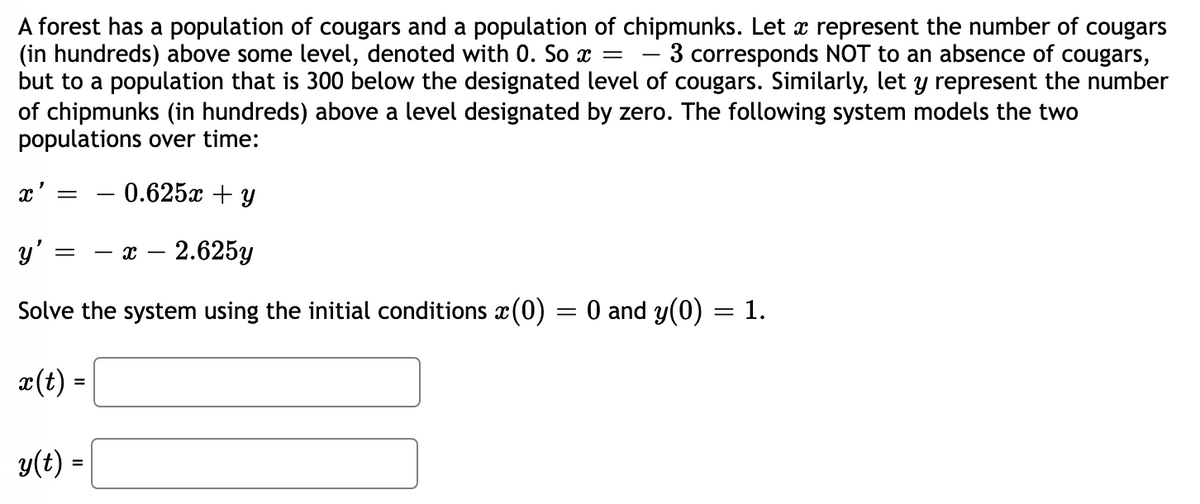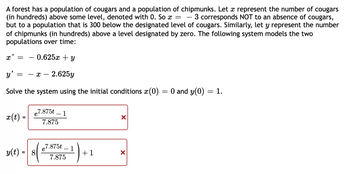A forest has a population of cougars and a population of chipmunks. Let a represent the number of cougars (in hundreds) above some level, denoted with 0. So x = 3 corresponds NOT to an absence of cougars, but to a population that is 300 below the designated level of cougars. Similarly, let y represent the number of chipmunks (in hundreds) above a level designated by zero. The following system models the two populations over time: x' = 0.625x + y y' = - x - 2.625y Solve the system using the initial conditions (0) = 0 and y(0) = 1. x(t) = y(t) = =
A forest has a population of cougars and a population of chipmunks. Let a represent the number of cougars (in hundreds) above some level, denoted with 0. So x = 3 corresponds NOT to an absence of cougars, but to a population that is 300 below the designated level of cougars. Similarly, let y represent the number of chipmunks (in hundreds) above a level designated by zero. The following system models the two populations over time: x' = 0.625x + y y' = - x - 2.625y Solve the system using the initial conditions (0) = 0 and y(0) = 1. x(t) = y(t) = =
Algebra for College Students
10th Edition
ISBN:9781285195780
Author:Jerome E. Kaufmann, Karen L. Schwitters
Publisher:Jerome E. Kaufmann, Karen L. Schwitters
Chapter11: Systems Of Equations
Section11.5: Cramer's Rule
Problem 35PS
Related questions
Question

Transcribed Image Text:A forest has a population of cougars and a population of chipmunks. Let a represent the number of cougars
(in hundreds) above some level, denoted with 0. So x = 3 corresponds NOT to an absence of cougars,
but to a population that is 300 below the designated level of cougars. Similarly, let y represent the number
of chipmunks (in hundreds) above a level designated by zero. The following system models the two
populations over time:
x' =
0.625x + y
y'
=
X 2.625y
Solve the system using the initial conditions (0)
x
=
= 0 and y(0) = 1.
x(t) =
y(t) =
Expert Solution
This question has been solved!
Explore an expertly crafted, step-by-step solution for a thorough understanding of key concepts.
Step by step
Solved in 5 steps with 4 images

Follow-up Questions
Read through expert solutions to related follow-up questions below.
Follow-up Question

Transcribed Image Text:A forest has a population of cougars and a population of chipmunks. Let à represent the number of cougars
(in hundreds) above some level, denoted with 0. So x = - 3 corresponds NOT to an absence of cougars,
but to a population that is 300 below the designated level of cougars. Similarly, let y represent the number
of chipmunks (in hundreds) above a level designated by zero. The following system models the two
populations over time:
x' =
- 0.625x + y
y'
=
x - 2.625y
Solve the system using the initial conditions (0)
=
0 and y(0) = 1.
1
x(t) =
e7.875t
7.875
X
y(t)
X
=
8
e7.875t
7.875
+1
Solution
Recommended textbooks for you

Algebra for College Students
Algebra
ISBN:
9781285195780
Author:
Jerome E. Kaufmann, Karen L. Schwitters
Publisher:
Cengage Learning

Linear Algebra: A Modern Introduction
Algebra
ISBN:
9781285463247
Author:
David Poole
Publisher:
Cengage Learning

Elementary Linear Algebra (MindTap Course List)
Algebra
ISBN:
9781305658004
Author:
Ron Larson
Publisher:
Cengage Learning

Algebra for College Students
Algebra
ISBN:
9781285195780
Author:
Jerome E. Kaufmann, Karen L. Schwitters
Publisher:
Cengage Learning

Linear Algebra: A Modern Introduction
Algebra
ISBN:
9781285463247
Author:
David Poole
Publisher:
Cengage Learning

Elementary Linear Algebra (MindTap Course List)
Algebra
ISBN:
9781305658004
Author:
Ron Larson
Publisher:
Cengage Learning